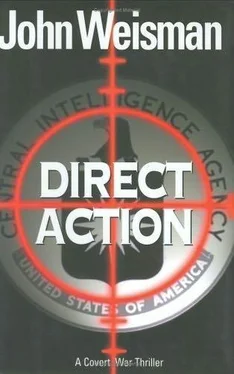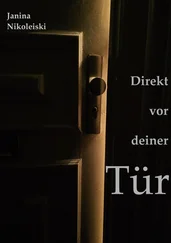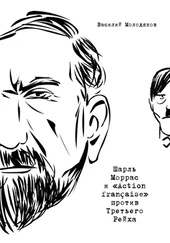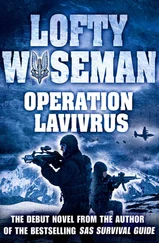Tom pulled a ten-meter cloth tape measure out of the tool kit and clipped it to the pocket of his coveralls. He straightened out the ladder and locked the sections in place. Then he inclined the rails against the wall section, snugged the antislip feet against the concrete, and climbed up until he was able to snag the hook end against the top of the crown molding. He handed the tape measure to Reuven. “Distance?”
The Israeli knelt and squinted. “Eight centimeters short.”
He vaulted onto the forklift and eased the wall upward while Tom held on to the ladder, then jumped down and checked the tape. “Only half a centimeter off.”
Tom unhooked the tape and let it fall, watching as Reuven caught the end one-handed. “Close enough for government work.”
11:35A.M. Tom tightened the elastic band on his protective goggles, leaned forward on the ladder so that he could put pressure on the silent drill, and squeezed the trigger. The bit overrevved and gouged a thumbnail-size hole in the rough plaster surface. “Goddamnit.” Tom released the trigger, wiped the bit clean, and prepared to start over.
From below, Reuven looked up. “You’re okay. Just take it slow and easy.”
“Gotcha.” Tom applied pressure cautiously, gauging carefully as the bit revolved ever so slowly. “Okay.” He stopped the drill, pressed the tip against the plaster, and eased his finger onto the trigger.
The bit began to turn slowly. Tom put some of his weight behind the drill and watched, satisfied, as the bit eased smoothly into the rough-surfaced plaster. Particles of fine dust floated down onto his coveralls.
Now he increased the speed of the drill, feeling momentary resistance as the bit passed through the plaster and chewed on the lath beneath.
He increased the revolutions. The plaster dust was now joined by tiny wood shavings, which were, in turn, followed by gray masonry dust. Tom pressed harder. The drill bore into the wall. He cocked his head to examine the metric markings on the bit. He’d penetrated just over ten centimeters so far. He’d be coming to the stone sheathing soon-and then it would be time to switch drill bits.
11:39A.M. Tom pulled the bit out of the wall. He was sweating now, and his arms had begun to ache from holding the drill rock-steady. He hung the drill off the utility belt he’d cinched around his waist, inserted a fiber-optic Snake-Lens Scope into the hole, and depressed the light button. The fiber-optic cable was 2.75 millimeters in diameter-just over a tenth of an inch. It had a close-focusing lens with a fifty-degree field of view. The scope had been designed for SWAT teams so they could peer under doors and into the interiors of locked cars and vans. It was an off-the-shelf model powered by double-A batteries. This one had red-light illumination. But you could get them with bright white, or blue, or even infrared light for clandestine operations. He’d bought the scope out of a police-supply catalog on a whim. It had cost just over three hundred dollars. Now he was glad he’d splurged. He turned the knurled fine-focus knob on the eyepiece until he was satisfied with what he saw, counted the striations, then dead-reckoned how much drilling was left undone.
He was getting close-certainly within an inch and a half of the adjoining wall. He extracted the fiber-optic scope, inserted his measuring rod, and squinted at the markings Reuven had etched on the aluminum as a guide. Yup - three-point-six centimeters to go . He retrieved the drill, removed the drill shaft, and replaced it with a long titanium 1mm bit. He double-checked to see that the bit was seated securely and then eased the unit back into the hole.
11:55A.M. “You’re through. Did you feel it?” Reuven was perched on a ladder on the opposite side of the wall.
“Yes.” Tom held the drill steady, eased it out, and hung it on his belt. He pulled the minivacuum up and sucked dust out of the hole, then inserted the fiber-optic. “Looks clean.”
Now he took the minicamera out of his breast pocket, activated the power, and, using the measuring rod, eased the device into the hole. As he did, he heard Reuven scramble down the ladder. “I’ll check the video.”
Tom waited until he heard Reuven say, “Okay-go.”
“Roger that.” He pushed on the rod, eyes focused on the measurements. “One-half centimeter.” He felt slight resistance. “See anything?”
“No.”
Tom grunted. He applied more pressure, pushing the camera another twenty-five millimeters. “Now?”
“Not yet.”
Tom examined the markings on the rod. The lens should have cleared the crown molding by now. He squinted and counted the lines etched on the rod. “You’re right, Reuven-I was one centimeter off.” Holding the rod steady, Tom pushed.
Too hard. The rod shot forward more than two centimeters-about half an inch.
“I can see very clearly now,” Reuven said facetiously.
“I’ll bet you can.” Tom was pissed. He’d shoved the goddamn camera right through the crown molding. He clambered down the ladder and went around the other side to examine his handiwork. He wasn’t impressed. “Jeezus H,” he said, hands on his hips. “Let’s do it all over again.”
12:36P.M. The entire back of Tom’s coveralls was wet with perspiration. The front was covered with dust from the drilling. But he didn’t care. He stared at the image on the monitor and grinned. It had taken three attempts, but he’d finally gotten it right. He looked over at Reuven, who gave him an upturned thumb and a mischievous grin. “Am I that big an asshole?”
“You show real promise, Tom. A few more run-throughs and we’ll make you into a regular second-story guy.”
“Thanks.” It might have been easier if Reuven had done the drilling, but Tom had insisted on doing the work himself. “I’m simply a little out of practice is all.”
Tom noted the noncommittal expression on Reuven’s face. Who was he kidding? The last time Tom worked with silent drills was during the breaking-and-entering refresher he’d taken down at the Farm in 2002 as an excuse to get out of the office. He was on shaky ground here and he knew it.
“If we have to drill from the back, maybe it would be better if you did it.”
“Nah.” Reuven waved a hand in a dismissive gesture. “You know what Suvorov said.”
“Suvorov?”
“Eighteenth-century Russian general. ‘Train hard, fight easy.’ That was his credo.” The Israeli jerked his thumb toward the wall section. “You’re getting the feel of it. We’ve got, what-a week perhaps, before we can move. By the time we do this for real, you’ll be fine.”
1:58P.M.
RUE LAMBERT, MONTMARTRE
Tom thought, You have to hand it to the bad guys: they plan well. This frigging street is going to be impossible. Rue Lambert was narrow-barely wide enough for a panel truck. It was short-just over fifty meters in length. It was one-way-dead-ending into another one-way street. It was the kind of street on which people know one another, where the one small bistro served the same customers every day. Where the owner of the corner café knows everyone in the neighborhood by name and keeps a wary eye out for strangers. It was, all in all, a perfect milieu for counter surveillance. And a lousy environment in which to do the surveilling.
Oh, it was possible. If you had a crew of sixty. You could run them through as tourists and workers, changing clothes and appearances over a ten-day period. Or if there was enough time to preplan, you could rent a flat-or break into one if the owners were away-and use it as an observation post. But Tom didn’t have sixty people, there was nothing for rent-he’d had his French employees check-and no one was on vacation. So there was no choice. They’d have to do this the hard way.
Читать дальше












